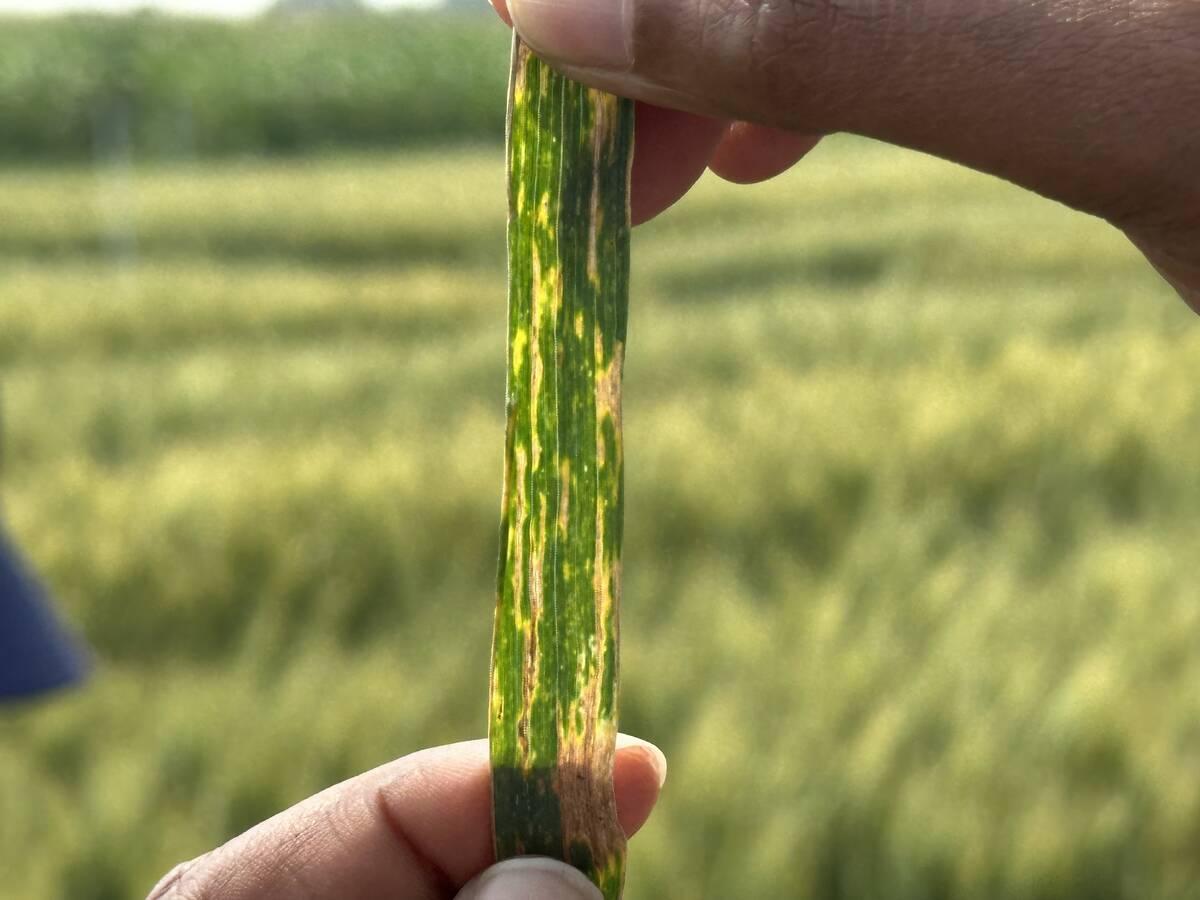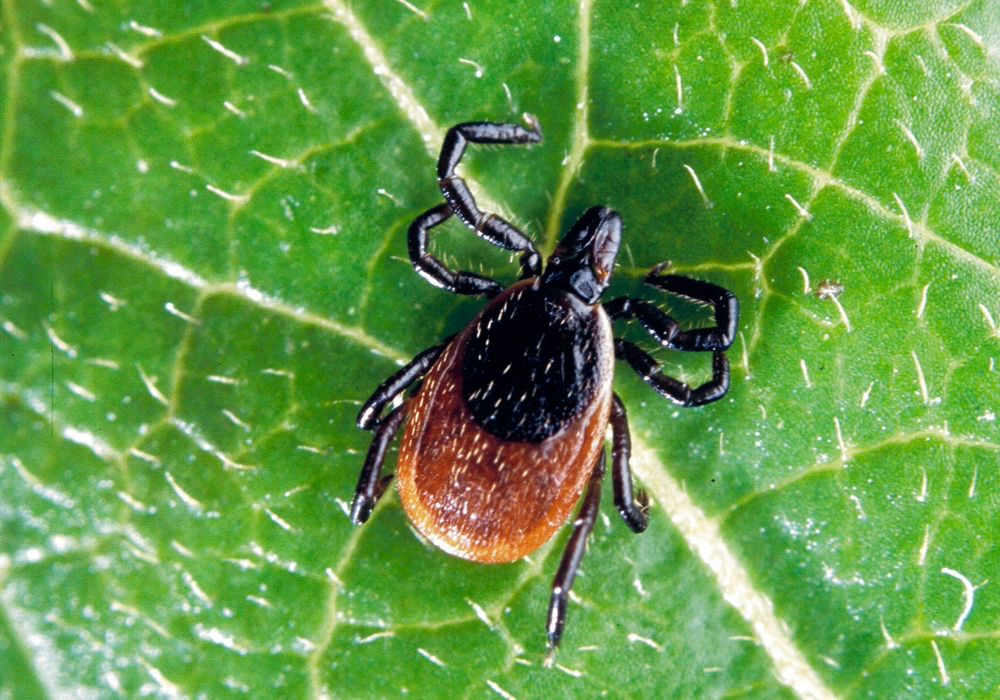Farmers need to be aware of the risks associated with tick bites and be prepared to protect their own health this spring.
That’s according to Kateryn Rochon, an entomologist and associate professor at the University of Manitoba, who says the province’s farm population is a high-risk group.
“By virtue of your job, you are exposed to tick bites,” Rochon said of farmers. “Don’t stop going outside, just work wisely.”
Rising risks
For the past few years, reported cases of Lyme diseases have increased in Manitoba — 70 last year, up from 64 in 2016, according to provincial figures.
Read Also

Researchers chase resistance to bacterial leaf streak
Bacterial leaf streak is re-emerging in cereal crops on Canada’s Prairies. With no fungicides or resistant varieties, researchers are testing plant genes for future control of the disease.
The illness, transmitted by the black-legged tick (or deer tick), commonly causes flu-like symptoms at first. If not properly treated, it can linger for months or even years and cause chronic arthritis or neurological effects, according to the USDA.
The rise in reported cases of Lyme disease has a few causes, said Rochon.
“There’s definitely more awareness, especially in the medical community,” Rochon said, explaining that in the past doctors were likely to shrug off aches and chills as a flu bug, but now they’re more likely to test for Lyme.
While each year the overall percentage of Lyme-infected ticks has stayed at about 20-25 per cent, that percentage represents a larger body of bugs. Rochon said they’ve found black-legged ticks in locations where they’ve never been found before.
“Behave as if there are black-legged ticks everywhere,” Rochon said.
She added that wood ticks (American dog ticks) rarely carry diseases. She has found a few lone star ticks, known for causing inexplicable red meat allergies, but these are “super rare” in Manitoba.
Tick safety
Ticks prefer moist, shaded environments; especially leafy wooded areas and overgrown grassy habitats, according to the Canadian Lyme Disease Foundation.
“The goal is to keep the tick from reaching your skin,” Rochon said.
- Read more: Tips for avoiding ticks
She suggests wearing long pants and tucking pant legs into socks so ticks can’t get underneath. Shirts should be tucked in for the same reason. Rubber boots are hard for ticks to climb and can hide the dorky sock-over-pants look, she said.
Additionally, Rochon recommended using repellent with DEET or icaridin (sometimes spelled ‘picaridin’) as active ingredients. Icaridin has fewer restrictions and less odour than DEET.
Repellent can be applied all over or, at minimum, from knee to ankle, at the wrists and neckline.
Rochon said it’s also important to do a full-body check for ticks at the end of the day. Ticks like warm, humid areas, such as the armpits, behind the knees, the pelvic region, and the crown of the head where a baseball cap usually sits.
When a tick is found, remove it, said Rochon.
She said she’s heard of people using gasoline or matches to remove a tick.
“Definitely don’t use gas and the match together,” she said.
Burning or squeezing may cause a tick to send a rush of potentially pathogen-carrying saliva into the bite.
If possible, she said, use tweezers to grasp the tick as close to the skin as possible and slowly pull it free.
However, black-legged ticks can range from the size of a poppy seed to a sesame seed. Bites might be hard to spot.
About 60 per cent of people infected with Lyme disease get a “bull’s eye” rash, at the site of the tick bite within three days to one month, the USDA’s website said. Others might only notice flu symptoms.
Rochon suggests that if someone finds a black-legged tick on themselves, or a tick they can’t identify, they should put it in a plastic bag or container, label it with the date, and keep it in the freezer.
If they start feeling sick, they can take the tick to the doctor and ask to be tested for Lyme.
If someone has Lyme-like symptoms, but can’t recall a tick bite, Rochon suggests telling the doctor that their job frequently exposes them to ticks.
In animals
Lyme disease can infect dogs, horses, cattle, and occasionally cats. Dogs can be vaccinated, but the Canadian Lyme Disease Foundation says this vaccine is relatively new.
The foundation also says about 50 per cent of horses will be infected with Lyme disease in their lifetime. Central Veterinary Services’s website said it can be treated with antibiotics, usually Doxycycline administered as a powder added to feed.
A Lyme vaccine for dogs has been used in horses, but Central Veterinary Services says this is still being tested and proven.
“Using this vaccine is off-label which means that it is not designed specifically to work in horses, and any adverse reactions will not be covered by the vaccine company,” its website says.
The website suggests using fly repellents containing permethrins, and grooming horses daily to check for ticks.
For cattle, there is no set pattern of symptoms, diagnosis or treatment of Lyme disease in cattle, according to the USDA. Clinical signs of Lyme are very similar to other diseases common to cattle.
















